
The Tower of London, officially His Majesty's Royal Palace and Fortress of the Tower of London, is a historic castle on the north bank of the River Thames in central London, England. It lies within the London Borough of Tower Hamlets, which is separated from the eastern edge of the square mile of the City of London by the open space known as Tower Hill. It was founded toward the end of 1066 as part of the Norman Conquest. The White Tower, which gives the entire castle its name, was built by William the Conqueror in 1078 and was initially a resented symbol of oppression, inflicted upon London by the new Norman ruling class. The castle was also used as a prison from 1100 until 1952, although that was not its primary purpose. A grand palace early in its history, it served as a royal residence. As a whole, the Tower is a complex of several buildings set within two concentric rings of defensive walls and a moat. There were several phases of expansion, mainly under kings Richard I, Henry III, and Edward I in the 12th and 13th centuries. The general layout established by the late 13th century remains despite later activity on the site.

Yeoman is a noun originally referring either to one who owns and cultivates land or to the middle ranks of servants in an English royal or noble household. The term was first documented in mid-14th-century England. The 14th century also witnessed the rise of the yeoman longbow archers during the Hundred Years' War, and the yeoman outlaws celebrated in the Robin Hood ballads. Yeomen also joined the English Navy during the Hundred Years' War as seamen and archers. In the early 15th century, yeoman was the rank of chivalry between page and squire. By the late 17th century, yeoman became a rank in the Royal Navy for the common seamen who were in charge of ship's stores, such as foodstuffs, gunpowder, and sails.

The Yeomen of the Guard; or, The Merryman and His Maid, is a Savoy Opera, with music by Arthur Sullivan and libretto by W. S. Gilbert. It premiered at the Savoy Theatre on 3 October 1888 and ran for 423 performances. This was the eleventh collaboration of fourteen between Gilbert and Sullivan.

The King's Body Guard of the Yeomen of the Guard is a bodyguard of the British monarch. The oldest British military corps still in existence, it was created by King Henry VII in 1485 after the Battle of Bosworth Field.
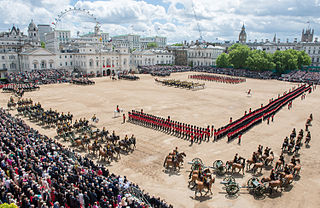
Trooping the Colour is a ceremonial event performed every year on Horse Guards Parade in London, United Kingdom, by regiments of Household Division, to celebrate the official birthday of the British sovereign. It is also known as the Sovereign's Birthday Parade. Similar events are held in other countries of the Commonwealth. In the UK, it is, with the State Opening of Parliament, the biggest event of the ceremonial calendar, and watched by millions on TV and on the streets of London.

Horse Guards Parade is a large parade ground off Whitehall in central London. It is the site of the annual ceremonies of Trooping the Colour, which commemorates the monarch's official birthday, and the Beating Retreat.

Guard mounting, changing the guard, or the changing of the guard, is a formal ceremony in which sentries performing ceremonial guard duties at important institutions are relieved by a new batch of sentries. The ceremonies are often elaborate and precisely choreographed. They originated with peacetime and battlefield military drills introduced to enhance unit cohesion and effectiveness in the late 17th and early 18th centuries.
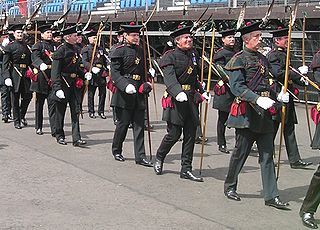
Sovereign's Bodyguard is the name given to three ceremonial units in the United Kingdom who are tasked with guarding the Sovereign. These units are:
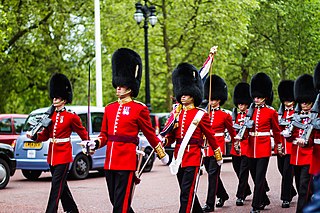
The King's Guard are sentry postings at Buckingham Palace and St James's Palace, organised by the British Army's Household Division. The Household Division also mounts sentry postings at Horse Guards, known as the King's Life Guard.
The Ghosts Of London is a book written by Henry Vollam Morton ("H.V."), published in 1939 by Methuen & Co Limited in London. Far from being on the subject of ghosts and the supernatural, Morton's book is instead a sentimental portrait of historic London juxtaposed with contemporary (1930s) London. The book is made up of 30 short histories and anecdotes, likely collected from his work as a journalist.
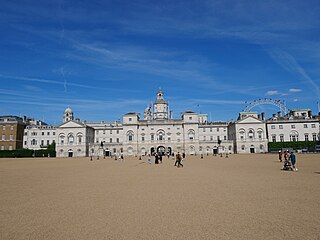
Horse Guards is a historic building in the City of Westminster, London, between Whitehall and Horse Guards Parade. It was built in the mid-18th century, replacing an earlier building, as a barracks and stables for the Household Cavalry. The current and previous buildings were, between the early 18th century and 1858, the main military headquarters for the British Empire. Horse Guards originally formed the entrance to the Palace of Whitehall and later St James's Palace; for that reason it is still ceremonially defended by the King's Life Guard.
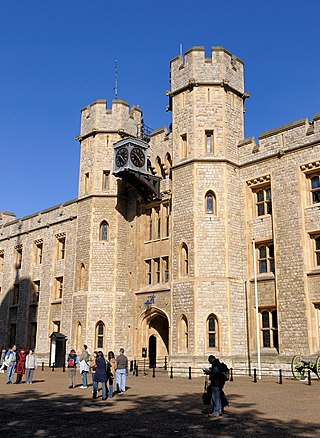
The Jewel House is a vault housing the British Crown Jewels in the Waterloo Block at the Tower of London. It was opened by Queen Elizabeth II in 1994 and refurbished in 2012. Regalia have been kept in various parts of the Tower since the 14th century after a series of successful and attempted thefts at Westminster Abbey.

Public duties are performed by military personnel, and usually have a ceremonial or historic significance rather than an overtly operational role.

Hwaseong Fortress or Suwon Hwaseong is a fortification surrounding the centre of Suwon, the provincial capital of Gyeonggi Province, in South Korea. It was built from 1794 to 1796 by King Jeongjo of the Joseon dynasty to house and honour the remains of his father, Prince Sado. Sado had been executed by being locked alive inside a rice chest by his own father King Yeongjo after failing to obey a command to commit suicide. Located 30 kilometres (19 mi) south of Seoul and enclosing much of central Suwon, the fortress includes King Jeongjo's palace Haenggung. The fortress and enclosed palace were designated as a World Heritage site by UNESCO in 1997. It comprises among many other features the palace, a perimeter wall, four main gates, and two sluicegates over the Suwoncheon, Suwon's main stream, which flows through the centre of the fortress.

Moira Cameron is a retired Yeoman Warder of the Tower of London, United Kingdom. She is the first woman to ever hold the position. In 2007, after a 22-year career in the British Army, Cameron became one of the 35 resident Warders in the Tower of London, commonly known as the Beefeaters.

Byward Street is a road in the City of London, the historic and financial centre of London. It forms part of the A3211 route and, if travelling eastward, is a short continuation of Lower Thames Street from a junction with Great Tower Street, to Tower Hill. It is located within the City ward of Tower.

The Yeomen Warders of His Majesty's Royal Palace and Fortress the Tower of London, and Members of the Sovereign's Body Guard of the Yeoman Guard Extraordinary, popularly known as the Beefeaters, are ceremonial guardians of the Tower of London. In principle they are the palace guard, responsible for looking after any prisoners in the Tower, and safeguarding the British crown jewels. They have also conducted guided tours of the Tower since the Victorian era.

The Ceremony of the Keys event is a re-enactment of the locking of the gates to the old Town and garrison of Gibraltar.

The Keys, more frequently known as the Yeoman Warders Club, is a non-public pub in the Tower of London, in England, open only to the members of the Yeomen Warders, and their guests. The Yeomen Warders, who are known colloquially as the "Beefeaters", are the guards of the Tower of London; as of 2020 there were 37 Beefeaters. Beefeaters generally live in the Tower along with their families, which led to the existence of a dedicated pub. The current name of the pub, "The Keys", refers to a nightly locking-up ritual in the Tower; the name is a recent change, and the establishment was historically known as the Yeoman Warders Club. Though numerous pubs used to exist in the Tower, this is the only remaining one, and is about 150 years old.

The Wanggung Sumunjang literally translates as door guard of the royal palace or Sumungun literally translates as military doorkeepers, for short is a royal guard unit of the Joseon Dynasty, whose primary duty is to guard the walls and gates of the Five palaces of Seoul.



















